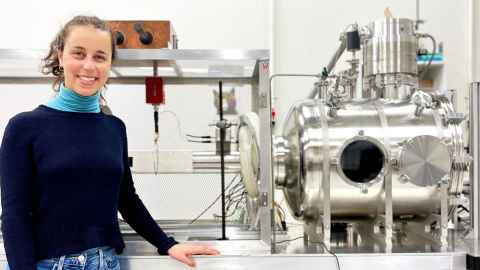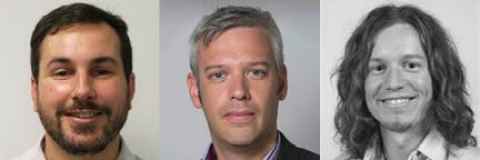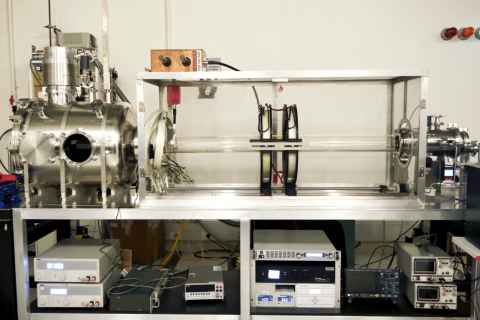Antonella Caldarelli
PhD student Antonella Caldrelli is charting new territory in the New Zealand space industry.

Have you ever thought about what makes the Aurora Australis light up the night sky? Or why lightning flashes during a storm? What about what creates the lights of the fiery tail of a comet?
All of these beautiful displays of light are created from the lesser-known fourth state of matter called plasma. (Fourth after solids, liquids and gasses.) Plasma is more numerous than any other type of matter in our known world, comprising over 90% of the visible universe. It is made up of very hot gasses that give it a large amount of energy. This energy plasma an attractive medium for research and technological advances.
Researching and harnessing plasma has helped with the modernization of electronics, the development of environmentally sustainable cleaning, and the creation of a cleaner form of nuclear power called fission.
Plasma is also used for advancements in space.
Antonella Caldarelli, a PhD student in Aerospace Engineering, is researching Thrust Vectoring of Plasma Thruster.
Ms. Caldarelli is studying a new type of electric propulsion system called radio-frequency plasma thruster, and is doing a focus on controlling the plasma direction through external magnetic fields for Attitude and Orbit Control (AOC) manoeuvres of spacecraft.
Simply put Ms. Caldarelli is trying to see if she can use magnetic fields to control the plasma direction for the orbit of spacecraft.
Before plasma the steering, or attitude, of a spacecraft had been done through chemical and mechanical means. Chemical systems are not environmentally sustainable, and mechanical systems are usually heavy, complex and delicate, which increase the likelihood of mission failures.
Plasma steering using magnetic fields, scientifically called Magnetic Thrust Vectoring (MTV), has no moving or rotational components, and creates the possibility of a simpler and more reliable orbit and attitude control system.
The thrust of the engine is created through exhausted plasma, and the satellites steering is controlled by modifying the orientation of a magnetic nozzle (the thing that guides, expands and accelerates plasma).
According to Ms. Caldarelli, “in the last decade, the aerospace industry has seen a boom in the manufacturing of small and nano-scale satellites” which are used for “space communications, environmental and weather monitoring, and scientific research.” Due to their small size, magnetic thrust vectoring would be the ideal Attitude and Orbit Control method for these satellites.
What makes Ms. Caldarelli’s PhD unique is that she is not only looking at magnetics of the plasma steering, but also the physics, which is why she has co-supervisors in aerospace engineering and physics, Dr. John Carter and Dr. Nicholas Rattenbury.
Radio-frequency plasmas in space propulsion technology is still a relatively new concept, having been researched for only the past 15 years. Ms. Caldarelli and her lab-mate, Felicien Filleul, a fourth year Physics PhD student, are the only researchers in New Zealand studying it.

Part of this research includes studying how plasma would expand in space when it gets exhausted from a thruster. Since the research is too far away to try on satellites in space and they did not have regular access to a vacuum system and plasma reactor in their lab, they made their own.
The plasma reactor, which they have named Moa, includes the plasma generation system, the vacuum system, the magnetic system, the electronics and the probes.
The vacuum chamber is 50 cm wide by 70 cm long and reaches pressure 10 times smaller than atmospheric pressure. The plasma source is a 1.5 m long and 9 cm diameter glass tube. Five custom-made magnets control the magnetic field topology (the effects of the magnetic force) of the experiment.
They created the layout and design of the vacuum chamber, and sent them to the US company Lesker to build it.
Moa enables them to study how plasma is generated, how it expands in space and how it characterises plasma thrust performance.

The most difficult part of Ms. Caldarelli’s research is taking measurements of and characterizing the plasma. A lot of noise can come from electronics which can interfere with readings and cause errors, even more so because Caldarelli and Filleul built their own diagnostic probes. Their budget did not allow them to purchase these instruments.
The probes especially break easily due to the harsh environment in the plasma, further impacting the data.
As with most experimental research there is a lot of trial and error, but as Ms. Caldarelli explains “when you see stuff is working and your measurements make sense you get really excited, and that is the greatest feeling.”
While it is sometimes frustrating being the only ones in New Zealand researching radio frequency plasmas and plasma thrust vectoring, it also grants them a lot of freedom, allowing them to choose the direction their research takes.
This freedom is part of the reason Ms. Caldarelli chose to study in New Zealand. New Zealand is still a relatively new country to the space industry, but it is growing fast. This uncharted territory allows PhD and masters candidates the freedom to follow their passions and interests, either continuing current research or mapping their own course.